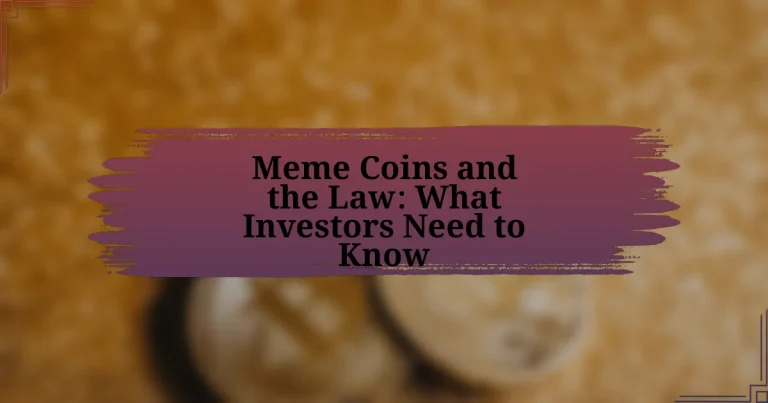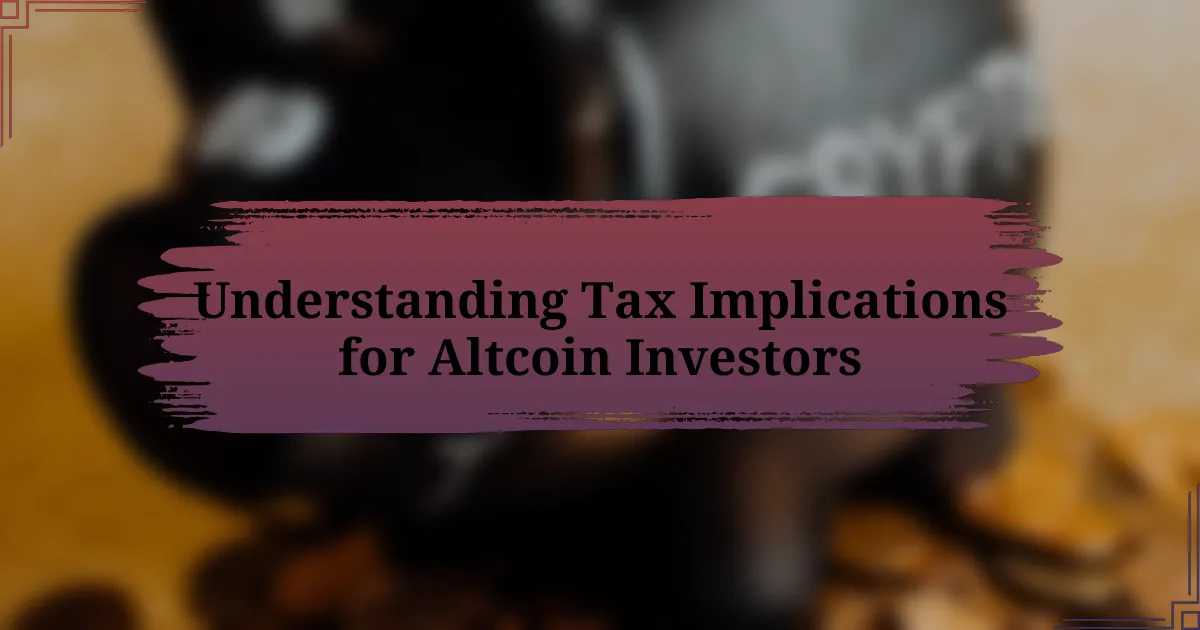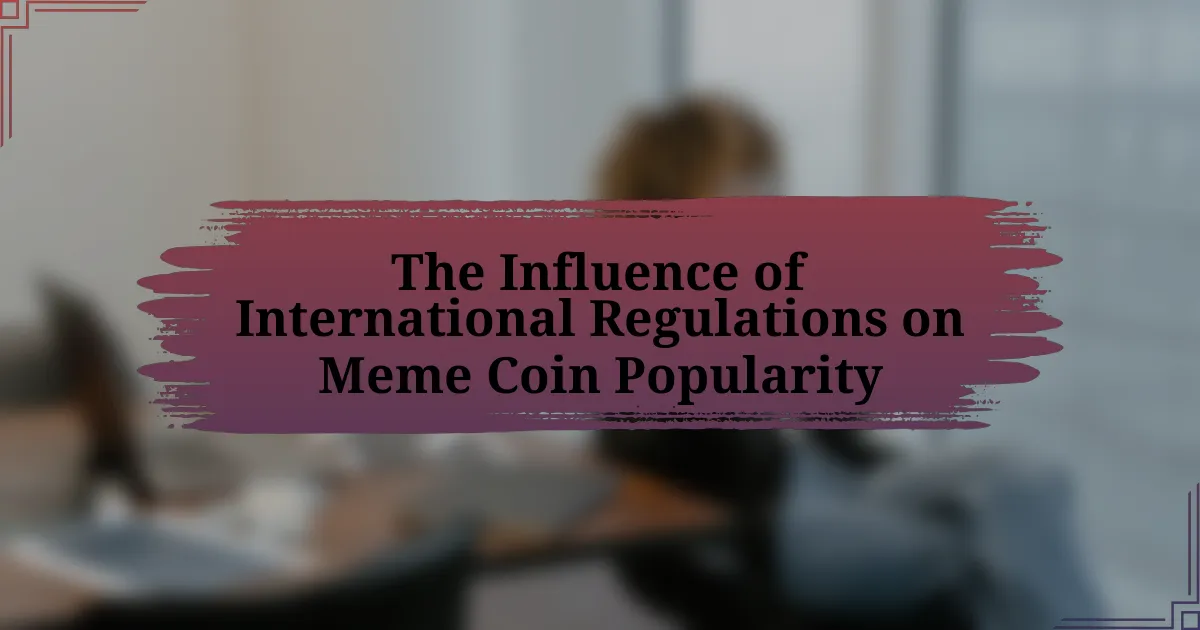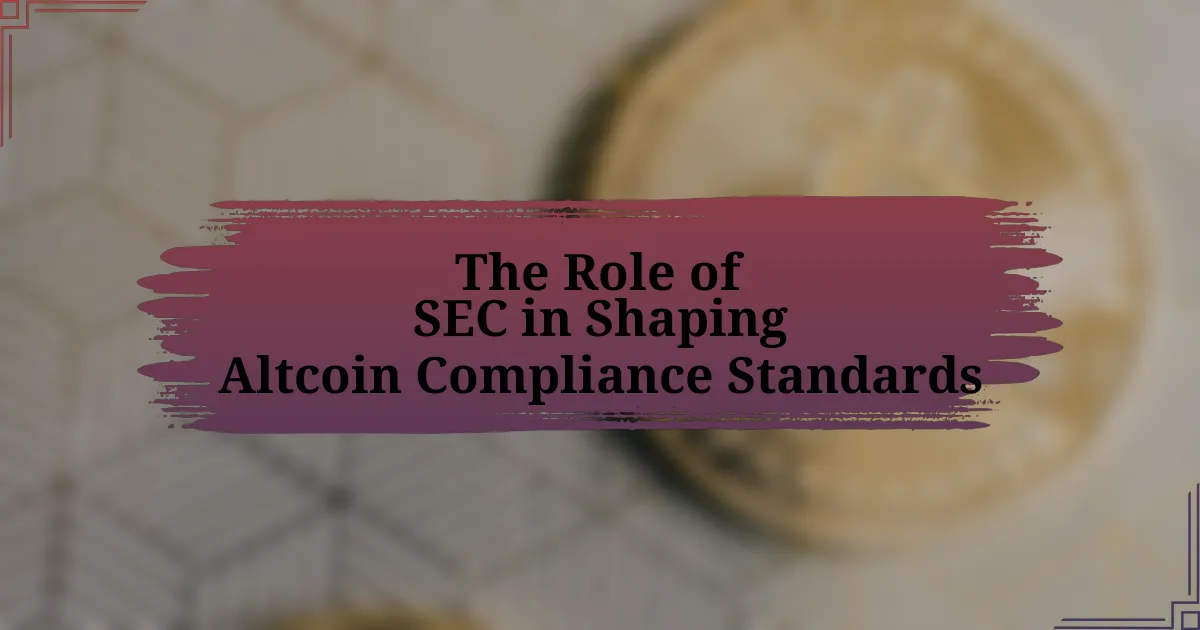Meme coins are a unique category of cryptocurrency often created as jokes or parodies, primarily driven by social media and internet culture rather than technological innovation. This article explores the characteristics that define meme coins, their differences from traditional cryptocurrencies, and popular examples such as Dogecoin and Shiba Inu. It also examines the factors contributing to their popularity among investors, including community engagement and social media influence, while addressing the legal considerations and risks associated with investing in these volatile assets. Additionally, the article provides strategies for investors to protect themselves in the meme coin market, emphasizing the importance of due diligence and market research.
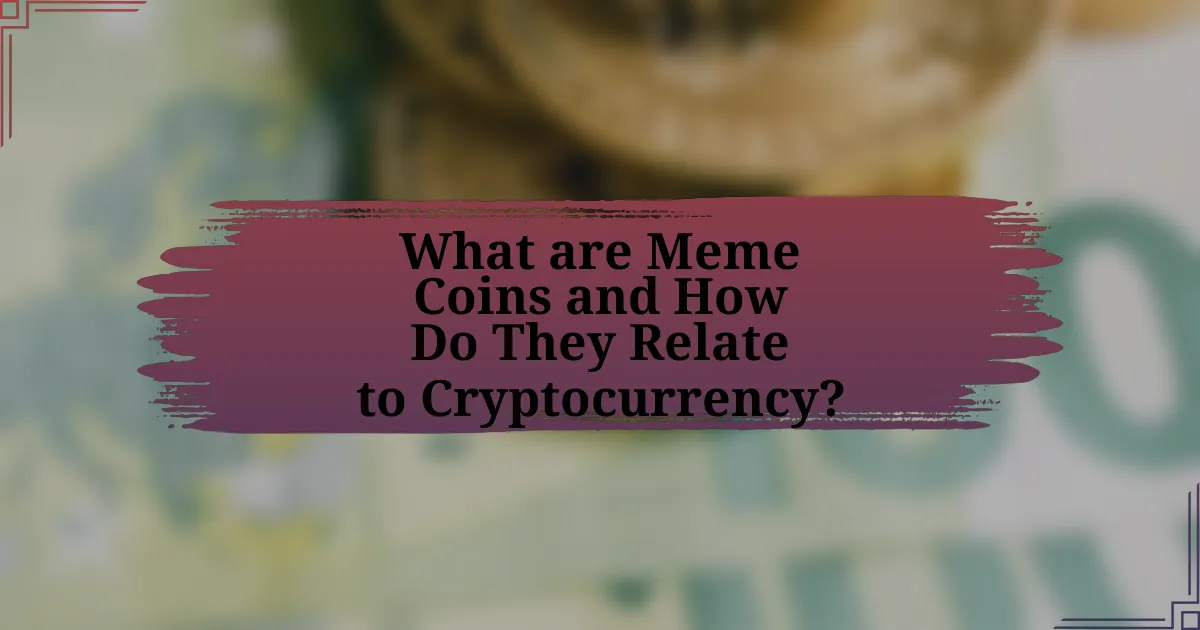
What are Meme Coins and How Do They Relate to Cryptocurrency?
Meme coins are a category of cryptocurrency that are often created as a joke or parody, typically inspired by internet memes or cultural phenomena. They relate to cryptocurrency as they operate on blockchain technology, similar to other cryptocurrencies, but usually lack the fundamental utility or serious backing that traditional cryptocurrencies possess. For example, Dogecoin, one of the most well-known meme coins, started as a meme featuring the Shiba Inu dog and gained popularity due to social media and community engagement rather than technological innovation or a specific use case.
What defines a meme coin in the cryptocurrency market?
A meme coin in the cryptocurrency market is defined as a digital currency that gains popularity primarily through social media and internet culture rather than through technological innovation or utility. These coins often originate from memes or internet jokes, with Dogecoin being one of the most notable examples, launched in 2013 as a parody of Bitcoin. The value of meme coins is largely driven by community engagement and speculative trading, rather than fundamental economic factors, which can lead to high volatility and risk for investors.
How do meme coins differ from traditional cryptocurrencies?
Meme coins differ from traditional cryptocurrencies primarily in their purpose and community-driven nature. While traditional cryptocurrencies like Bitcoin and Ethereum are designed for specific use cases such as digital currency or smart contracts, meme coins often emerge from internet culture and social media trends, primarily serving as speculative assets. For instance, Dogecoin, initially created as a joke, gained popularity through community engagement and viral marketing rather than technological innovation or utility. This distinction highlights that meme coins typically lack the foundational technology and use cases that characterize established cryptocurrencies, making them more volatile and reliant on social sentiment for value.
What are some popular examples of meme coins?
Some popular examples of meme coins include Dogecoin, Shiba Inu, and SafeMoon. Dogecoin, created in 2013, gained popularity due to its Shiba Inu dog logo and community-driven initiatives. Shiba Inu, launched in 2020, is often referred to as the “Dogecoin killer” and has garnered significant attention in the cryptocurrency market. SafeMoon, introduced in 2021, became well-known for its unique tokenomics, which incentivize holding rather than selling. These coins have gained traction primarily through social media and community engagement, reflecting the influence of internet culture on cryptocurrency trends.
Why have meme coins gained popularity among investors?
Meme coins have gained popularity among investors primarily due to their viral nature and community-driven marketing. The rise of social media platforms, particularly Twitter and Reddit, has facilitated rapid dissemination of information and trends, allowing meme coins like Dogecoin and Shiba Inu to capture public interest. Additionally, the low entry price of these coins attracts retail investors looking for high-risk, high-reward opportunities. For instance, Dogecoin saw a surge in value from $0.002 in early 2021 to over $0.70 by May 2021, demonstrating the potential for significant returns. This combination of community engagement, social media influence, and speculative investment has contributed to the growing allure of meme coins in the cryptocurrency market.
What role does social media play in the rise of meme coins?
Social media significantly accelerates the rise of meme coins by facilitating rapid information dissemination and community engagement. Platforms like Twitter, Reddit, and TikTok enable users to share memes, trading tips, and news about specific coins, creating viral trends that attract new investors. For instance, the surge in popularity of Dogecoin can be attributed to social media campaigns and endorsements from high-profile figures, which led to a substantial increase in its market capitalization, reaching over $85 billion at its peak in May 2021. This demonstrates how social media not only influences public perception but also drives investment behavior in the cryptocurrency market.
How do community engagement and hype influence meme coin value?
Community engagement and hype significantly influence meme coin value by driving demand and market interest. High levels of community interaction, such as active discussions on social media platforms and participation in events, create a sense of belonging and loyalty among investors, which can lead to increased buying activity. For instance, the rise of Dogecoin was largely fueled by its community’s enthusiasm and viral marketing campaigns, resulting in a market capitalization that peaked at over $85 billion in May 2021. Additionally, hype generated through media coverage and celebrity endorsements can lead to rapid price surges, as seen when Elon Musk tweeted about Dogecoin, causing its value to spike dramatically. This correlation between community engagement, hype, and meme coin value illustrates how social dynamics can impact financial markets.
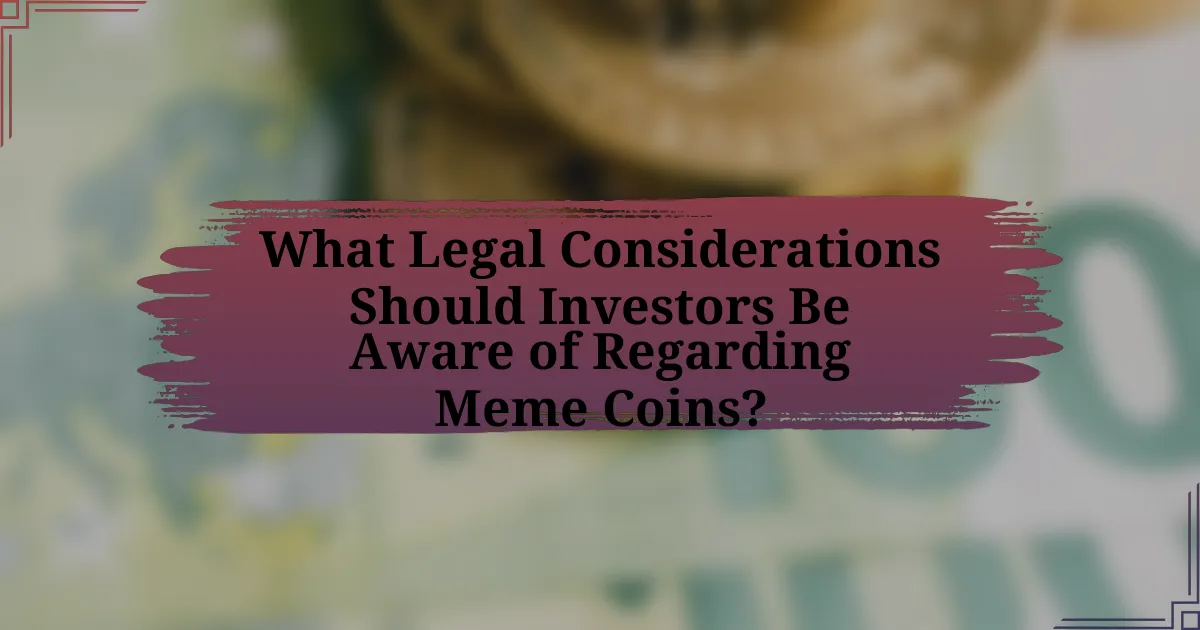
What Legal Considerations Should Investors Be Aware of Regarding Meme Coins?
Investors should be aware that meme coins often fall into a legal gray area, primarily due to their classification as cryptocurrencies and the lack of regulatory clarity surrounding them. The U.S. Securities and Exchange Commission (SEC) has indicated that some cryptocurrencies may be classified as securities, which would subject them to federal securities laws. This classification depends on whether the coin is being offered as an investment with the expectation of profits derived from the efforts of others, as established in the Howey Test.
Additionally, meme coins can be associated with high volatility and potential fraud, leading to legal risks for investors. For instance, the rise of pump-and-dump schemes in the meme coin market has prompted regulatory scrutiny. Investors should also consider the implications of anti-money laundering (AML) and know your customer (KYC) regulations, which may apply depending on the exchange used for trading these coins.
Furthermore, intellectual property issues may arise if a meme coin uses copyrighted material without permission, exposing investors to potential legal liabilities. Overall, the evolving regulatory landscape necessitates that investors conduct thorough due diligence and stay informed about the legal status of meme coins in their jurisdiction.
What regulations currently apply to meme coins?
Meme coins currently fall under various regulations depending on the jurisdiction, primarily focusing on securities laws and anti-money laundering (AML) regulations. In the United States, the Securities and Exchange Commission (SEC) has indicated that some meme coins may be classified as securities, which would subject them to registration requirements and compliance with federal securities laws. Additionally, the Financial Crimes Enforcement Network (FinCEN) enforces AML regulations that apply to cryptocurrency exchanges and issuers, requiring them to implement Know Your Customer (KYC) protocols. In the European Union, the Markets in Crypto-Assets (MiCA) regulation is being developed to provide a comprehensive framework for crypto assets, including meme coins, emphasizing consumer protection and market integrity. These regulatory frameworks aim to mitigate risks associated with fraud and market manipulation in the cryptocurrency space.
How do different countries approach the regulation of meme coins?
Different countries approach the regulation of meme coins with varying degrees of strictness and frameworks. For instance, the United States primarily classifies meme coins under existing securities laws, leading to scrutiny from the Securities and Exchange Commission (SEC) regarding their compliance with regulations. In contrast, countries like El Salvador have embraced cryptocurrencies, including meme coins, with a more lenient regulatory stance, promoting their use as legal tender. Meanwhile, nations such as China have imposed outright bans on cryptocurrency trading, including meme coins, citing financial stability concerns. These diverse regulatory approaches reflect each country’s economic priorities and attitudes toward digital assets.
What are the implications of securities laws on meme coins?
Securities laws significantly impact meme coins by determining whether they are classified as securities. If a meme coin is deemed a security, it must comply with registration requirements and disclosure obligations under laws such as the Securities Act of 1933. This classification hinges on the Howey Test, which assesses whether an investment involves an expectation of profits derived from the efforts of others. For instance, the SEC has scrutinized various cryptocurrencies, including meme coins, to ensure compliance, leading to legal actions against projects that fail to meet these standards. Consequently, meme coin creators and investors face legal risks, including potential penalties and restrictions on trading, if these coins are classified as securities without proper registration.
What risks do investors face when dealing with meme coins?
Investors face significant risks when dealing with meme coins, primarily due to their extreme volatility and lack of regulatory oversight. The prices of meme coins can fluctuate dramatically within short periods, often driven by social media trends rather than fundamental value, leading to potential substantial financial losses. Additionally, many meme coins are susceptible to scams and fraudulent schemes, as the decentralized nature of cryptocurrencies allows for the creation of tokens without rigorous vetting processes. For instance, a report by the Financial Conduct Authority in the UK highlighted that 2.3 million people had invested in cryptocurrencies, with a significant portion involving high-risk assets like meme coins, underscoring the prevalence of investor vulnerability in this space.
How can scams and fraud affect meme coin investments?
Scams and fraud can significantly undermine meme coin investments by eroding investor trust and leading to substantial financial losses. The prevalence of fraudulent schemes, such as pump-and-dump tactics and fake initial coin offerings (ICOs), can result in investors losing their entire investment as these scams often promise unrealistic returns. According to a report by the Federal Trade Commission, cryptocurrency-related scams have cost consumers over $1 billion since 2021, highlighting the financial impact of such fraudulent activities. Additionally, the lack of regulatory oversight in the meme coin market makes it easier for scammers to operate, further increasing the risk for investors.
What are the potential legal consequences of investing in meme coins?
Investing in meme coins can lead to various legal consequences, including regulatory scrutiny, potential fraud allegations, and tax implications. Regulatory bodies like the SEC have expressed concerns about the lack of consumer protection in the cryptocurrency market, which can result in investigations or enforcement actions against projects deemed to be misleading or fraudulent. Additionally, if a meme coin is classified as a security, investors may face legal repercussions related to unregistered offerings. Furthermore, profits from meme coin investments are subject to capital gains tax, and failure to report these gains can lead to penalties from tax authorities.
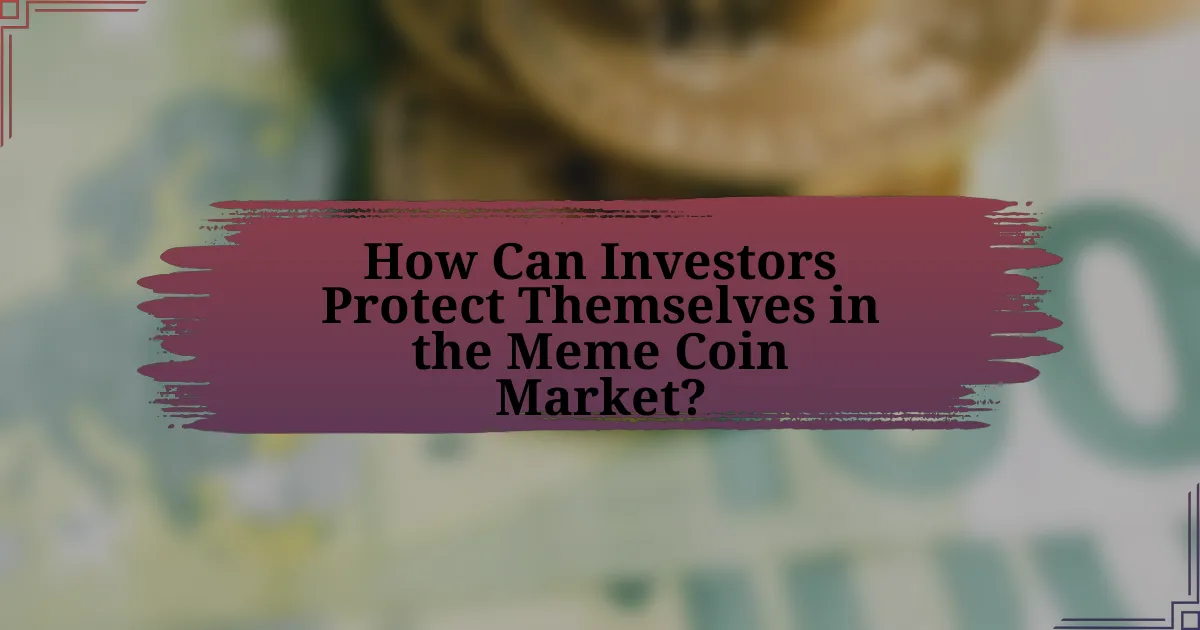
How Can Investors Protect Themselves in the Meme Coin Market?
Investors can protect themselves in the meme coin market by conducting thorough research and due diligence before investing. This includes analyzing the project’s whitepaper, understanding the team behind the coin, and assessing the community engagement and market trends. According to a report by Chainalysis, over 80% of meme coins have little to no utility, which highlights the importance of evaluating the project’s fundamentals. Additionally, investors should diversify their portfolios to mitigate risks associated with the high volatility of meme coins. Implementing stop-loss orders can also help limit potential losses.
What best practices should investors follow when investing in meme coins?
Investors should conduct thorough research and due diligence before investing in meme coins. This includes understanding the project’s fundamentals, the team behind it, and the community support, as many meme coins lack substantial utility or backing. For instance, the rise of Dogecoin was largely driven by community engagement and social media presence rather than technological innovation. Additionally, investors should only allocate a small portion of their portfolio to meme coins due to their high volatility and speculative nature. Historical data shows that meme coins can experience rapid price fluctuations, making it essential to manage risk effectively. Lastly, staying informed about regulatory developments is crucial, as the legal landscape surrounding cryptocurrencies is evolving, which can impact the viability of meme coins.
How can due diligence help mitigate risks associated with meme coins?
Due diligence can significantly mitigate risks associated with meme coins by enabling investors to thoroughly assess the legitimacy and potential of these cryptocurrencies. Conducting due diligence involves researching the project’s whitepaper, understanding the team behind the coin, and analyzing market trends and community engagement. For instance, a study by the University of Cambridge highlighted that informed investors who evaluate the fundamentals of a cryptocurrency are less likely to fall victim to scams or market volatility. By verifying the credibility of the project and its developers, investors can avoid investing in fraudulent schemes, thereby reducing financial losses.
What resources are available for staying informed about meme coin regulations?
To stay informed about meme coin regulations, investors can utilize several key resources. Regulatory bodies such as the U.S. Securities and Exchange Commission (SEC) and the Financial Conduct Authority (FCA) provide official updates and guidelines on cryptocurrency regulations, including meme coins. Additionally, reputable financial news outlets like CoinDesk and CoinTelegraph regularly publish articles and analyses on the evolving regulatory landscape. Furthermore, legal firms specializing in cryptocurrency law often release white papers and newsletters that detail recent developments and compliance requirements. These resources collectively offer comprehensive insights into the regulatory environment surrounding meme coins.
What strategies can investors use to navigate the meme coin landscape?
Investors can navigate the meme coin landscape by conducting thorough research, diversifying their portfolios, and setting clear investment goals. Researching the underlying technology, community engagement, and market trends of specific meme coins helps investors make informed decisions. Diversification across various meme coins reduces risk, as the volatility of individual coins can lead to significant losses. Setting clear investment goals, such as profit targets and risk tolerance, allows investors to manage their investments effectively. Historical data shows that meme coins can experience rapid price fluctuations; for instance, Dogecoin surged over 14,000% in 2021, highlighting the potential for both gains and losses.
How can diversification help in managing meme coin investments?
Diversification can help in managing meme coin investments by reducing risk and enhancing potential returns. By spreading investments across various meme coins rather than concentrating on a single asset, investors can mitigate the impact of volatility inherent in the meme coin market. For instance, if one meme coin experiences a significant decline, other coins in the portfolio may perform better, balancing overall performance. Historical data shows that diversified portfolios tend to have lower volatility and higher risk-adjusted returns compared to concentrated investments, making diversification a strategic approach in the unpredictable landscape of meme coins.
What role does market research play in successful meme coin investing?
Market research is crucial for successful meme coin investing as it helps investors understand market trends, community sentiment, and potential risks. By analyzing data on social media engagement, trading volumes, and investor demographics, individuals can identify which meme coins have strong community backing and growth potential. For instance, a study by CoinMarketCap in 2021 indicated that meme coins with active online communities, such as Dogecoin, often experienced significant price surges, demonstrating the impact of community sentiment on value. Therefore, thorough market research enables investors to make informed decisions, minimizing risks and maximizing potential returns in the volatile meme coin market.
What are the common pitfalls to avoid when investing in meme coins?
Common pitfalls to avoid when investing in meme coins include lack of research, emotional decision-making, and ignoring market volatility. Investors often fail to conduct thorough research on the project, its team, and its community, leading to uninformed decisions. Emotional decision-making can result in buying during hype or panic selling during downturns, which is common in the highly volatile meme coin market. Additionally, ignoring market volatility can lead to significant financial losses, as meme coins can experience rapid price fluctuations. According to a report by the Financial Conduct Authority, many investors in cryptocurrencies, including meme coins, do not fully understand the risks involved, which underscores the importance of informed investing.
How can emotional decision-making impact meme coin investments?
Emotional decision-making can significantly impact meme coin investments by leading to impulsive buying or selling based on market sentiment rather than rational analysis. Investors often react to social media trends, celebrity endorsements, or fear of missing out, which can result in volatility and price swings. For instance, during the Dogecoin surge in 2021, many investors bought in due to emotional excitement rather than fundamental value, causing rapid price increases followed by sharp declines when sentiment shifted. This behavior illustrates how emotions can drive market dynamics, often resulting in losses for those who do not adhere to a disciplined investment strategy.
What signs indicate a potentially risky meme coin investment?
Signs that indicate a potentially risky meme coin investment include a lack of transparency from the developers, which can manifest as anonymous team members or vague project details. Additionally, if the coin has a high concentration of ownership, where a small number of wallets hold a significant portion of the supply, it raises concerns about market manipulation. Furthermore, the absence of a clear use case or utility for the coin often suggests speculative trading rather than genuine value. Historical data shows that many meme coins experience extreme volatility and rapid price fluctuations, which can lead to significant financial losses for investors. Lastly, if the project relies heavily on social media hype and influencer endorsements without substantial backing or community engagement, it may indicate a higher risk of failure.

